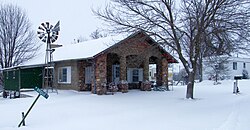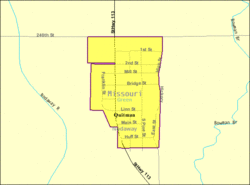2010 census
As of the census [11] of 2010, there were 45 people, 23 households, and 11 families living in the city. The population density was 346.2 inhabitants per square mile (133.7/km2). There were 27 housing units at an average density of 207.7 per square mile (80.2/km2). The racial makeup of the city was 100.0% White.
There were 23 households, of which 26.1% had children under the age of 18 living with them, 39.1% were married couples living together, 8.7% had a female householder with no husband present, and 52.2% were non-families. 43.5% of all households were made up of individuals, and 17.3% had someone living alone who was 65 years of age or older. The average household size was 1.96 and the average family size was 2.73.
The median age in the city was 44.5 years. 20% of residents were under the age of 18; 4.4% were between the ages of 18 and 24; 26.7% were from 25 to 44; 37.7% were from 45 to 64; and 11.1% were 65 years of age or older. The gender makeup of the city was 48.9% male and 51.1% female.
2000 census
As of the census [3] of 2000, there were 46 people, 21 households, and 11 families living in the town. The population density was 331.1 inhabitants per square mile (127.8/km2). There were 24 housing units at an average density of 172.7 per square mile (66.7/km2). Everybody in the town was white.
There were 21 households, out of which six had children under the age of 18 living with them, ten were married couples living together, one had a female householder with no husband present, and nine were non-families. Nine of all households were made up of individuals, and three had someone living alone who was 65 years of age or older. The average household size was 2.19 and the average family size was 3.00.
In the town the population was spread out, with thirteen people under the age of 18, one between 18 and 24, ten from 25 to 44, seventeen from 45 to 64, and five who were 65 years of age or older. The median age was 44 years. In town, there were twenty-three males (of whom sixteen were over age 18), and twenty-three females (of whom seventeen were over age 18).
The median income for a household in the town was $29,375, and the median income for a family was $31,250. Males had a median income of $21,250 versus $16,500 for females. The per capita income for the town was $11,644. There were 10.5% of families and 21.0% of the population living below the poverty line, including 36.8% of under eighteens and none of those over 64.



